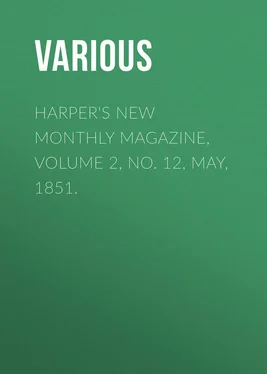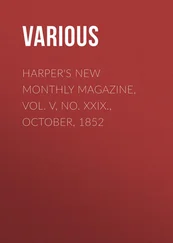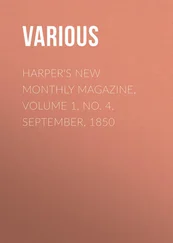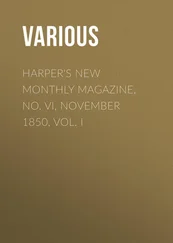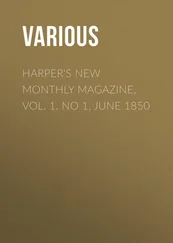Various - Harper's New Monthly Magazine, Volume 2, No. 12, May, 1851.
Здесь есть возможность читать онлайн «Various - Harper's New Monthly Magazine, Volume 2, No. 12, May, 1851.» — ознакомительный отрывок электронной книги совершенно бесплатно, а после прочтения отрывка купить полную версию. В некоторых случаях можно слушать аудио, скачать через торрент в формате fb2 и присутствует краткое содержание. Издательство: Иностранный паблик, Жанр: periodic, foreign_edu, на английском языке. Описание произведения, (предисловие) а так же отзывы посетителей доступны на портале библиотеки ЛибКат.
- Название:Harper's New Monthly Magazine, Volume 2, No. 12, May, 1851.
- Автор:
- Издательство:Иностранный паблик
- Жанр:
- Год:неизвестен
- ISBN:нет данных
- Рейтинг книги:3 / 5. Голосов: 1
-
Избранное:Добавить в избранное
- Отзывы:
-
Ваша оценка:
- 60
- 1
- 2
- 3
- 4
- 5
Harper's New Monthly Magazine, Volume 2, No. 12, May, 1851.: краткое содержание, описание и аннотация
Предлагаем к чтению аннотацию, описание, краткое содержание или предисловие (зависит от того, что написал сам автор книги «Harper's New Monthly Magazine, Volume 2, No. 12, May, 1851.»). Если вы не нашли необходимую информацию о книге — напишите в комментариях, мы постараемся отыскать её.
Harper's New Monthly Magazine, Volume 2, No. 12, May, 1851. — читать онлайн ознакомительный отрывок
Ниже представлен текст книги, разбитый по страницам. Система сохранения места последней прочитанной страницы, позволяет с удобством читать онлайн бесплатно книгу «Harper's New Monthly Magazine, Volume 2, No. 12, May, 1851.», без необходимости каждый раз заново искать на чём Вы остановились. Поставьте закладку, и сможете в любой момент перейти на страницу, на которой закончили чтение.
Интервал:
Закладка:
When the cylinder is freed from the pressure of the sand around it, in its bed, the great iron cross by which the mould was lowered into the pit, as seen in the engraving of the Casting, is once more brought down to its place, and the stirrups at the tops of the iron rods seen in the engraving below, are brought over the ends of the arms of the cross. The lower ends of these rods take hold of a frame or platform below, upon which the whole mould, together with the cylinder within it, is supported. The arm of the crane is then brought round to the spot. The hook pendant from it is attached to the ring in the centre of the cross, and by means of the wheels and machinery of the crane, the whole is slowly hoisted out, and then swung round to some convenient level, where the ponderous mass is freed from its casing of masonry, and brought out at last to open day. It is then thoroughly examined with a view to the discovery of any latent flaw or imperfection, and, if found complete in every part, is conveyed away to be the subject of a long series of finishing operations in another place, – operations many and complicated, but all essential to enable it finally to fulfill its functions.
These cylinders though very massive and ponderous are not the heaviest castings made. They are much exceeded in weight by what is called a bed plate, which is an enormous frame of iron cast in one mass, or else in two or three separate masses and then strongly bolted together, to form a foundation on which the engine is to rest in the hold of the ship. The bed plate can not be seen in the view of the engine room already given, as it lies below the floor, being underneath all the machinery. A bed plate weighs sometimes thirty-five tons – which is the weight of about five hundred men. Such a mass as this has to be transported on ways, like those used in the launching of a ship. It is drawn along upon these ways by blocks and pullies, and when brought alongside the ship is hoisted on board by means of an enormous derrick, and let down slowly to the bottom of the hold – the place where it is finally to repose, unless perchance it should at last be liberated by some disaster, from this dungeon, and sent to seek its ultimate destination in the bottom of the sea.
The engraving below represents the forges, where all those parts of the machinery are formed and fitted which consist of wrought iron. The room in which these forges are situated is called the smith's shop, in the plan. In the back-ground, a little to the right, is one of the trip hammers, in the act of striking. The trip-hammer is a massive hammer carried by machinery. The machinery which drives it may at any time be thrown in or out of gear, so that the blows of the hammer are always under the control of the workman. The iron bar to be forged is far too heavy to be held by hand. It is accordingly supported as seen in the engraving, by a crane; and only guided to its place upon the anvil by the workmen who have hold of it. The chain to which this bar is suspended comes down from a little truck which rests upon the top of the crane, and which may be made to traverse to and fro, thus carrying whatever is suspended from it further outward, or drawing it in, as may be required. All the cranes, both in the smith's shop and in the foundry, are fitted with the same contrivance. These trucks are moved by means of a wheel at the foot of the crane.
On the extreme right of the picture, and somewhat in the distance, may be seen another trip-hammer with a bar upon the anvil beneath it, this bar being suspended likewise from a crane. When the iron becomes too cold to yield any longer to the percussion, the hammer is stopped, the crane is swung round, and the iron is replaced in the forge to be heated anew; and at length, when heated, it is brought back again under the hammer as before.
The forging of shafts requires heavier machinery even than this. The enormous mass of iron that is in this case to be forged, is bricked up in a furnace to be heated, and remains there many hours. The masonry is then broken away and the red hot beam is swung round under the hammer, as seen below. It is suspended from the crane by heavy chains, and is guided by the workmen by means of iron handles clamped to it at a distance from the heated part, as seen in the engraving in the adjoining column. The hammer is lifted by means of the cam below it, as seen in the engraving below. This cam is a projection from an axis revolving beneath the floor, and which, as it revolves, carries the cams successively against a projection upon the under side of the hammer, which is partly concealed in the engraving by the figure of the man. When the point of the cam has passed beyond the projection it allows the hammer to fall.
While the process of forging such a shaft is going on, one man throws water upon the work, to effect some purpose connected with the scaling of the iron, while another, with an instrument called the callipers, measures the diameter of the shaft, to regulate the size, as the forging proceeds.
The shafts, when forged, are to be turned in a lathe, and the engine used for this purpose is represented on the left in the engraving below. The shaft itself is seen in the lathe, while the tool which cuts it as it revolves, is fixed firmly in the "rest," which slides along the side. The point of the tool is seen in the engraving, with the spiral shaving which it cuts falling down from it. The shaft is made to revolve by the band seen coming down obliquely from above, at the hither end of the engine. The wheel by which the band turns the lathe has different grooves at different distances from the centre, in order that the workmen may regulate the velocity of the rotation – as different degrees of velocity are required for the different species of work. The rest , to which the cutting tool is attached, is brought slowly along the side of the shaft as the shaft revolves, by means of a long screw which is concealed in the frame of the lathe, and which is turned continually by the mechanism of the small wheels which are seen at the hither end of the engine.
On the right hand of this view is represented another kind of lathe called a face lathe , which is employed for turning wheels, and flat plates, and interiors of cavities, and such other pieces of work as do not furnish two opposite points of support. In the fore-ground are a company of men drawing a massive piece of iron upon a truck, destined apparently to be turned in the left hand lathe.
Although thus a great part of the work in respect to all the details of the engine, is performed by machinery, much remains after all to be wrought and fashioned by hand. In passing through the establishment the visitor finds the workmen engaged in these labors, in every conceivable attitude and position. One man is filing a curved surface with a curved file, another is hidden almost wholly from view within a great misshapen box of iron: a third is mounted upon a ladder, and is slowly boring through the wall of some monstrous formation, or cutting away excrescences of iron from some massive casting with a cold chisel. In a word, the details are so endlessly varied as to excite the wonder of the beholder that any human head should have been capable of containing them all, so as to have planned and arranged the fitting of such complicated parts with any hope of their ever coming rightly together.
They do come together, however, at last, and then follows the excitement of the trial. There is nothing more striking in the history of the construction of a steam engine than this, that there can be no partial or private tests of the work by the workmen in the course of its progress – but every thing remains in suspense until all is complete, and the ship and the machinery are actually ready for sea. The immense and ponderous masses which constitute the elements of the mighty structure are hoisted slowly on board and let down into their places. Multitudes of men are incessantly employed for many weeks in arranging the limbs and members of the monster, and in screwing and bolting every thing into its place. Still nothing can be tried. The machinery is too ponderous and massive to be put in action by any power less than that of the mighty mover on which its ultimate performance is to depend; and this mover has not yet been called into being.
Читать дальшеИнтервал:
Закладка:
Похожие книги на «Harper's New Monthly Magazine, Volume 2, No. 12, May, 1851.»
Представляем Вашему вниманию похожие книги на «Harper's New Monthly Magazine, Volume 2, No. 12, May, 1851.» списком для выбора. Мы отобрали схожую по названию и смыслу литературу в надежде предоставить читателям больше вариантов отыскать новые, интересные, ещё непрочитанные произведения.
Обсуждение, отзывы о книге «Harper's New Monthly Magazine, Volume 2, No. 12, May, 1851.» и просто собственные мнения читателей. Оставьте ваши комментарии, напишите, что Вы думаете о произведении, его смысле или главных героях. Укажите что конкретно понравилось, а что нет, и почему Вы так считаете.
